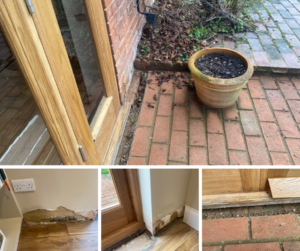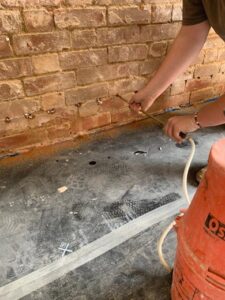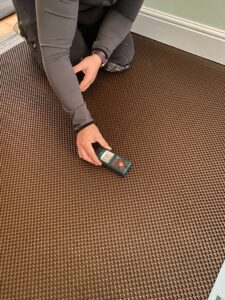Penetrating damp is caused by water entering your home from against the external walls, for example from faulty rain goods, or high ground levels. It can also occur through the walls of a basement or cellar. The important factor in differentiating penetrating damp from rising damp, is that the moisture moves across the wall from outside to inside.
Rising damp happens when the earth is saturated with water which rises up through a building that either has no, or a bridged damp proof course (DPC); either through having high ground levels outside, or plaster being applied on the interior down to the floor.
Penetrating and rising damp can both happen to a house of any age but are commonly seen on period homes and listed buildings. Interestingly, many people believe that the Public Health Act of 1875 made damp proof courses compulsory in the construction of ne houses but in fact, that is not the case. The Act does however begin to introduce byelaws in certain boroughs and districts that improved the living conditions of residents, mainly regarding the ‘draining’ of properties, the protection of water supplies to dwellings and the removal of putrid and stagnant water. London did introduce compulsory DPCs around the same time as the Act, so this is possibly where the confusion occurs.
What allows salt contaminated plaster to occur?
Water can enter the home from any number of sources, so if you’ve seen salt residue on your paintwork, ask yourself these questions:
- Does your home have a slate DPC, or is it old enough that it wasn’t built with one at all?
- Are your paths or garden higher than your damp proof course?
- Are your drains free flowing and far enough away from the house?
- Is your guttering in a good state of repair?
- Do you have any cracks on your external render or brickwork?
- Is your garden tap leaking?
How to fix salts in the walls
Your first port of call is to call in a damp specialist to survey the problem and identify the root cause. Is it penetrating damp, or is it rising damp? Once the root cause is remedied, you can instruct your damp specialist to carry out the work required to dry out the wall and prevent it from recurring.
In our experience the main culprit of salt contaminated walls is a failed DPC. In the easier to remedy scenarios it is because the outside ground has become higher over time, due to landscaping for example, and the DPC has been bridged. This is simple to fix by removing the higher ground and installing waterproof membrane, such as Delta 3mm mesh to the interior. You may need to treat the exterior walls with a chemical DPC in some cases.

In the more complicated scenario, rising damp may be the cause of the salt deposits, which means further investigation beneath the floor. The treatment for the damp problem is the same as with penetrating damp, but you may need to replace rotten wall plates or joist ends in the wooden floor as well.

If your floor is concrete, then a floor membrane such as Delta 4mm FM can be tied into the wall membrane to create a fully waterproof barrier on the inside. These membranes work in conjunction with the injected chemical DPC from the outside and the removal of the root cause, to prevent the damp from coming back.

Property Conservation Services offers a free survey of your damp problems as well as acting as your primary remedial damp specialist to carry out any work that is required.
Act now to remedy your damp problems to protect the structure and value of your home. Book a survey today.

